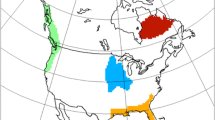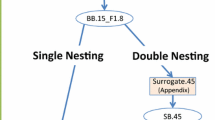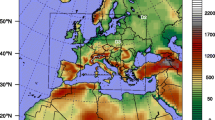Abstract
In this study, we investigate the response of a Regional Climate Model (RCM) to errors in the atmospheric data used as lateral boundary conditions (LBCs) using a perfect-model framework nick-named the “Big-Brother Experiment” (BBE). The BBE has been designed to evaluate the errors due to the nesting process excluding other model errors. First, a high-resolution (45 km) RCM simulation is made over a large domain. This simulation, called the Perfect Big Brother (PBB), is driven by the National Centres for Environmental Prediction (NCEP) reanalyses; it serves as reference virtual-reality climate to which other RCM runs will be compared. Next, errors of adjustable magnitude are introduced by performing RCM simulations with increasingly larger domains at lower horizontal resolution (90 km mesh). Such simulations with errors typical of today’s Coupled General Circulation Models (CGCM) are called the Imperfect Big-Brother (IBB) simulations. After removing small scales in order to achieve low-resolution typical of today’s CGCMs, they are used as LBCs for driving smaller domain high-resolution RCM runs; these small-domain high-resolution simulations are called Little-Brother (LB) simulations. The difference between the climate statistics of the IBB and those of PBB simulations mimic errors of the driving model. The comparison of climate statistics of the LB to those of the PBB provides an estimate of the errors resulting solely from nesting with imperfect LBCs. The simulations are performed over the East Coast of North America using the Canadian RCM, for five consecutive February months (from 1990 to 1994). It is found that the errors contained in the large scales of the IBB driving data are transmitted to and reproduced with little changes by the LB. In general, the LB restores a great part of the IBB small-scale errors, even if they do not take part in the nesting process. The small scales are seen to improve slightly in regions with important orographic forcing due to the finer resolution of the RCM. However, when the large scales of the driving model have errors, the small scales developed by the LB have errors as well, suggesting that the large scales precondition the small scales. In order to obtain correct small scales, it is necessary to provide the accurate large-scale circulation at the lateral boundary of the RCM.













Similar content being viewed by others
References
Antic S, Laprise R, Denis B, de Elía R (2004) Testing the downscaling ability of a one-way nested regional climate model in regions of complex topography. Clim Dyn 23:473–493
Bergeron G, Laprise R, Caya D (1994) Formulation of the mesoscale compressible community (MC2) model. Cooperative Centre for Research in Mesometeorology, 165pp [Available from Prof. R. Laprise, Département des Sciences de la Terre et de l’Atmosphère, Université du Québec à Montréal, C.P. 8888, Succursale “Centre-Ville,” Montréal, PQ, H3C 3P8, QC Canada]
Boer GJ, Lambert JS (2001) Second-order space-time climate difference statistics. Clim Dyn 17:213–218
CAS/JSC WGNE (1998) Report of fourteenth session of the CAS/JSC working group on numerical experimentation, Montréal, QC, Canada, No. 14, WMO/TD-NO. 964. World Meteor Org, 28 pp
CAS/JSC WGNE (1999) Report of fifteenth session of the CAS/JSC working group on numerical experimentation, Monterey, CA, USA, No. 15, WMO/TD-NO. 1024. World Meteor Org, 29 pp
Caya D, Laprise R (1999) A semi-implicit semi-Lagrangian regional climate model: the Canadian RCM. Mon Weather Rev 127:341–362
Davies HC (1976) A lateral boundary formulation for multi-level prediction models. Q J R Meteorol Soc 102:405–418
Denis B, Côté J, Laprise R (2002a) Spectral decomposition of two-dimensional atmospheric fields on limited-area domains using the discrete cosine transform (DCT). Mon Weather Rev 130:1812–1829
Denis B, Laprise R, Caya D, Côté J (2002b) Downscaling ability of one-way nested regional climate model: the Big-Brother Experiment. Clim Dyn 18:627–646
Denis B, Laprise R, Caya D (2003) Sensitivity of a regional climate model to the spatial resolution and temporal updating frequency of lateral boubdary conditions. Clim Dyn 20:107–126
Diaconescu EP (2006) La réponse d’un modèle régional du climat aux erreurs du pilote. Atmospheric Sciences Masters thesis, Earth and Atmospheric Sciences Departement, UQAM [Available from the corresponding author]
Dimitrijevic M, Laprise R (2005) Validation of the nesting technique in a regional climate model and sensitivity tests to the resolution of the lateral boundary conditions during summer. Clim Dyn 25:555–580
Duffy PB, Govindasamy B, Iorio JP, Milovich J, Sperber KR, Taylor KE, Wehner MF, Thompson SL (2003) High-resolution simulations of global climate, part 1: present climate. Clim Dyn 21:371–390
de Elía R, Laprise R, Denis B (2002) Forecasting skill limits of nested, limited-area models: a perfect-model approach. Mon Weather Rev 130:2006–2023
Fiorino M (1997) AMIP II sea surface temperature and sea ice concentration observartions. http://www.pcmdi.llnl.gov/amip/AMIP2EXPDSN/BCS_OBS/amip2_bcs.htm
Gal-Chen T, Sommerville RCJ (1975) On the use of a coordinate transformation for the solution of the Navier-Stokes equations. J Comput Phys 17:209–228
Herceg D, Sobel AH, Sun L, Zebiak SE (2006) The Big Brother Experiment and predictability issues in NCEP regional spectral model. Clim Dyn 27:69–82
Jones RG, Murphy JM, Noguer M (1995) Simulation of climate change over Europe using a nested regional-climate model. I: assessment of control climate, including sensitivity to location of lateral boundaries. Q J R Meteorol Soc 121:1413–1449
Kalnay E et al (1996) The NCEP-NCAR 40-year reanalyses project. Bull Am Meteorol Soc 77:437–471
Laprise R, Caya D, Bergeron G, Giguère M (1997) The formulation of André Robert MC2 (Mesoscale Compressible Community) model. In: Lin C, Laprise R, Ritchie H (eds) The André J. Robert memorial volume. Atmos Ocean 35:195–220
Laprise R, Caya D, Giguère M, Bergeron G, Côté H, Blanchet JP, Boer G, McFarlane NA (1998) Climate and climate change in western Canada as simulated by the Canadian regional climate model. Atmos Ocean 36:119–167
Mesinger F, Brill K, Chuang, H, DiMego G, Rogers E (2002) Limited area predictability: can upscailing also take place? Research Activities in Atmospheric and Oceanic Modelling, No. 32, WMO/TD-No.1105, pp 5.30–5.31
Noguer M, Jones R, Murphy J (1998) Sources of systematic errors in the climatology of a regional climate model over Europe. Clim Dyn 14:691–712
Risbey JS, Stone PH (1996) A case study of the adequacy of GCM simulations for input to regional climate change assessments. J Clim 9:1441–1467
Robert A, Yakimiw E (1986) Identification and elimination of an inflow boundary computational solution in limited area model integrations. Atmos Ocean 24:369–385
Taylor KE (2001) Summarizing multiple aspects of model performance in single diagram. J Geophys Res 106:7183–7192
Yakimiw E, Robert A (1990) Validation experiments for a nested grid-point regional forecast model. Atmos Ocean 28:466–472
Acknowledgments
This research was done as partial requirement for the MSc. Thesis of the first author, as a project within the CRCM Network, financially supported by the Canadian Foundation for Climate and Atmospheric Sciences (CFCAS) and the Ouranos Consortium on Regional Climatology and Adaptation to Climate Change. The technical help of the Climate Simulations Team of Ouranos is greatly appreciated; we are particularly thankful to Dr. Ramón de Elía for the useful discussions and to Mr. Claude Desrochers for maintaining a user-friendly local computing environment.
Author information
Authors and Affiliations
Corresponding author
Rights and permissions
About this article
Cite this article
Diaconescu, E.P., Laprise, R. & Sushama, L. The impact of lateral boundary data errors on the simulated climate of a nested regional climate model. Clim Dyn 28, 333–350 (2007). https://doi.org/10.1007/s00382-006-0189-6
Received:
Accepted:
Published:
Issue Date:
DOI: https://doi.org/10.1007/s00382-006-0189-6




